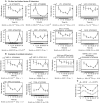Time-resolved interaction proteomics of the GIGANTEA protein under diurnal cycles in Arabidopsis
- PMID: 30536871
- PMCID: PMC6373471
- DOI: 10.1002/1873-3468.13311
Time-resolved interaction proteomics of the GIGANTEA protein under diurnal cycles in Arabidopsis
Abstract
The plant-specific protein GIGANTEA (GI) controls many developmental and physiological processes, mediating rhythmic post-translational regulation. GI physically binds several proteins implicated in the circadian clock, photoperiodic flowering, and abiotic stress responses. To understand GI's multifaceted function, we aimed to comprehensively and quantitatively identify potential interactors of GI in a time-specific manner, using proteomics on Arabidopsis plants expressing epitope-tagged GI. We detected previously identified (in)direct interactors of GI, as well as proteins implicated in protein folding, or degradation, and a previously uncharacterized transcription factor, CYCLING DOF FACTOR6 (CDF6). We verified CDF6's direct interaction with GI, and ZEITLUPE/FLAVIN-BINDING, KELCH REPEAT, F-BOX 1/LIGHT KELCH PROTEIN 2 proteins, and demonstrated its involvement in photoperiodic flowering. Extending interaction proteomics to time series provides a data resource of candidate protein targets for GI's post-translational control.
Keywords: Arabidopsis thaliana; affinity purification; circadian rhythms; flowering time; quantitative mass spectrometry.
© 2018 The Authors. FEBS Letters published by John Wiley & Sons Ltd on behalf of Federation of European Biochemical Societies.
Figures




References
-
- Dodd AN, Kusakina J, Hall A, Gould PD and Hanaoka M (2014) The circadian regulation of photosynthesis. Photosynth Res 119, 181–190. - PubMed
-
- Millar AJ (2016) The intracellular dynamics of circadian clocks reach for the light of ecology and evolution. Annu Rev Plant Biol 67, 595–618. - PubMed
-
- Flis A, Sulpice R, Seaton DD, Ivakov AA, Liput M, Abel C, Millar AJ and Stitt M (2016) Photoperiod‐dependent changes in the phase of core clock transcripts and global transcriptional outputs at dawn and dusk in Arabidopsis . Plant, Cell Environ 39, 1955–1981. - PubMed
Publication types
MeSH terms
Substances
Associated data
- Actions
- Actions
- Actions
- Actions
- Actions
- Actions
- Actions
- Actions
- Actions
- Actions
- Actions
- Actions
- Actions
- Actions
- Actions
- Actions
- Actions
- Actions
- Actions
- Actions
- Actions
- Actions
- Actions
- Actions
- Actions
- Actions
- Actions
- Actions
- Actions
- Actions
- Actions
- Actions
- Actions
- Actions
- Actions
- Actions
- Actions
- Actions
- Actions
- Actions
- Actions
- Actions
- Actions
- Actions
- Actions
- Actions
- Actions
- Actions
- Actions
- Actions
- Actions
- Actions
- Actions
- Actions
- Actions
- Actions
- Actions
- Actions
- Actions
- Actions
- Actions
- Actions
- Actions
- Actions
- Actions
- Actions
- Actions
- Actions
- Actions
- Actions
- Actions
- Actions
- Actions
- Actions
- Actions
- Actions
- Actions
- Actions
- Actions
- Actions
- Actions
- Actions
- Actions
- Actions
- Actions
- Actions
- Actions
- Actions
- Actions
- Actions
- Actions
- Actions
- Actions
- Actions
- Actions
- Actions
- Actions
- Actions
- Actions
- Actions
- Actions
- Actions
- Actions
Grants and funding
LinkOut - more resources
Full Text Sources
Molecular Biology Databases

